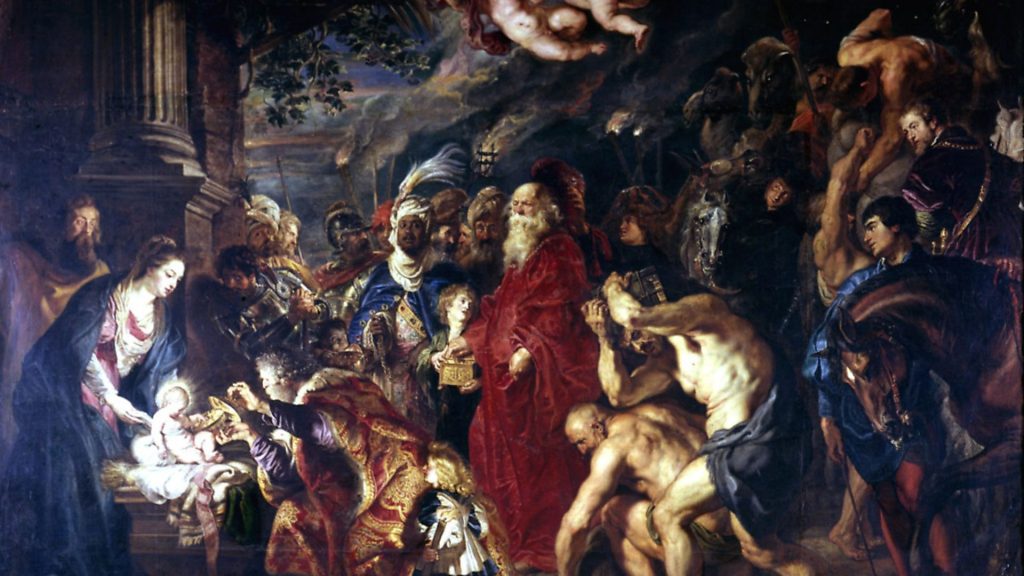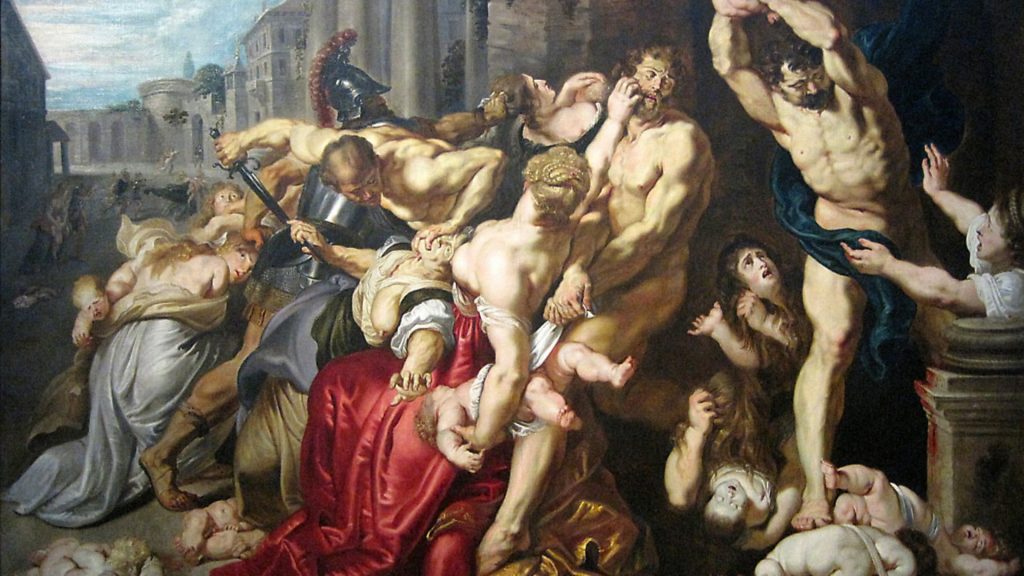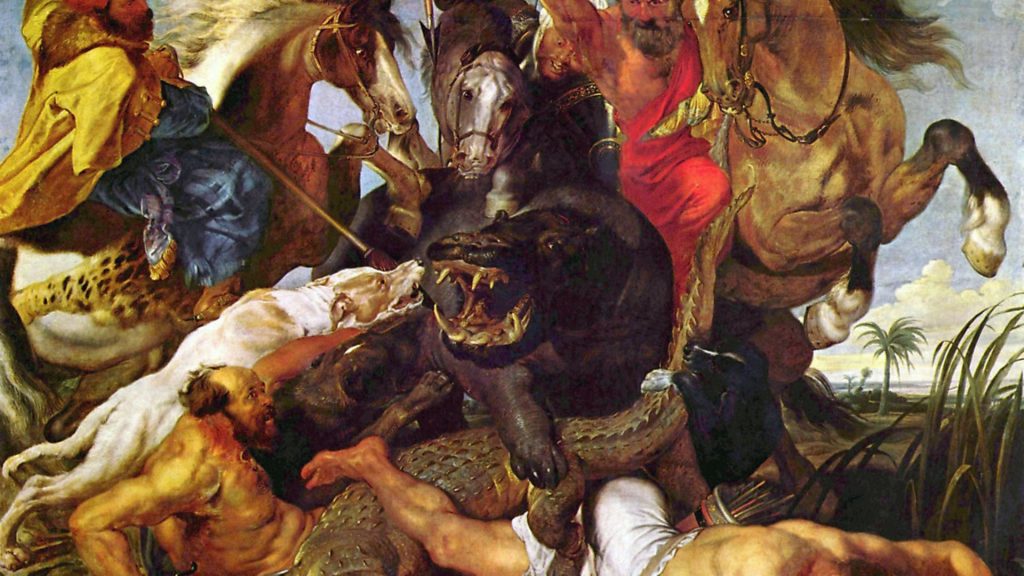
Rubens got in among our basic desires and our raw physicality and he gave them form

Munich’s art gallery, the Alte Pinakothek, when it was designed in the 1820s, was designed around one painting – Peter Paul Rubens’ The Last Judgement.
The painting is huge; it is more than six metres high, almost five metres wide and is one of the largest of all European canvasses. When the gallery was designed the proportions of the room that would exhibit The Last Judgement were set by the size of the painting. The design of the rest of the galleries followed on from this.
The painting is epic. It is huge not just in size, but also in theme. It is Heaven versus Hell, God versus Satan with the damned being dragged down to the depths and the saved being raised up to salvation. The painting is full of striking, though hardly subtle, juxtapositions: light versus dark, flesh versus death, angels versus demons. As such it is easy to see that the whole painting, which was painted between 1614 and 1617, is a great big slab of Counter-Reformation propaganda for the Catholic faith.
The Last Judgement was originally painted for Wolfgang Wilhelm, Count Palatine of Neuburg (now in modern Bavaria). When it was painted the Dutch and Spanish were embroiled in the Eighty Years’ War and the Holy Roman Empire was on the verge of the Thirty Years’ War. These conflicts, which were savage, genocidal affairs, were, as well as being about power and authority, essentially wars between the Catholic and Protestant faiths. These conflicts are echoed in our own time by the wars and battles being fought in Aleppo and Mosul. They were wars between irreconcilable factions with fundamentalist views, and as the conflicts continued they dragged more and more people into the fight. These wars, like today’s in Syria and Iraq, were humanity’s open sores.

At the heart of the Thirty Years War and the Dutch-Spanish war was a fundamental question about how people understood the world and their own lives and deaths. On the one side you have a world explained to you by a powerful authority, the Church, with much of this explaining being done through images, icons and symbols. On the other hand you have a world explained to you through words. The invention of the printing press meant that Bibles – and Bibles not printed in Latin but in the vernacular – could be disseminated with ease throughout Europe. If you could read then your relationship with God, and therefore your relationship with life and death, became something that was personal, introspective and reflective. It didn’t needs images or rituals, Popes and priests.
The impulse away from the authority of the Catholic Church and towards the personal and the private was a democratic impulse. It was reflected in the rise of a class of self-made men in Northern Europe, merchants and bankers, who were becoming as powerful as the Church and who were shaping the world in new ways that directly challenged popes and bishops. Much of the fight was about power, authority and wealth but it was also a fight about the very stuff of life, with the very stuff of life being how we reconcile ourselves to our death: are we fallen and damaged creatures born to suffer or are we, through work and imagination and discipline, able to make and shape our lives and our world?
Life versus death, words versus images, the future versus the past, private versus public – these were some of the fundamental issues that these wars were fought over and as such they were raw, existential wars that split countries and cities and towns. They were wars that were so violent and terrifying that they lurked in the European imagination, especially the German imagination, until the killing fields of Flanders and the Holocaust became the new benchmarks for how debased and terrible men could be. This troubled age also produced some of the greatest art in the entire Western canon – and it also produced some of the most full-on bonkers art in the entire Western canon. And of all those artists Rubens was one of the greatest and he was also one of the most bonkers. Wolfgang Wilhelm had converted to the Catholic faith and it can be assumed that this painting, which was to be displayed in the Jesuit church at Neuburg an Der Donau, was designed to signify Wilhelm’s devout Catholicism to the Church and to their Jesuit shock troops. If that was the plan then Ruben’s giant slab of propaganda worked. Wilhelm remained neutral in The Thirty Years War and Neuburg avoided the terrible destruction and the horrors that befell so many other towns and villages in that hellish conflict.
But there is more to this picture than it just being Counter-Reformation agitprop. Its composition is magnificent. The figures moving up to heaven and down to hell form a circle and convey a sense of movement – a sense of movement that is structured around light. This movement conveys a sense of time that is metaphysical with both the temporal and eternal being conveyed.

Rubens has, in this picture, captured time and light and movement in a way that transcends the Christian subject matter. You don’t have to be a believer to be bowled over it by it. You don’t have to be a Christian, and I’m certainly not, to be thrilled by the raw humanism of this painting which is about time, death and morality.
And the main reason why this picture transcends its Catholic subject matter is because this painting also has the thing that Rubens is most famous for. It has plump ladies with big bums. Rubens was obsessed by flesh; young flesh, old flesh, men’s flesh, woman’s flesh, dead flesh, damaged flesh, the flesh of children and angels and saints. His paintings are packed with the stuff.
Sometimes Rubens’s obsession with flesh was erotic – so for example his painting of Leda and the Swan is bestial and quasi pornographic, his portrait of his second wife Helene Fourment barely wearing a fur coat is lustful voyeurism. Most intriguing of all in its eroticism is his painting Christ and the Penitent Sinners. This picture has Mary Magdalene covering, or holding, her breasts as she bends over in front of a lean, muscular and stripped Jesus, her head near his groin. The picture is intriguing partly because of Rubens’s (very funny) portrayal of Christ as a sexy Christ but it is also intriguing because it is a painting about penitence. Penitence and forgiveness constituted some of the key fault lines in the row between the Protestant Reformation and the Catholic Counter-Reformation. Arguing against the selling of indulgences – the buying of a form of penitence from the Catholic Church – by Luther and his followers was also an argument for individuals to take responsibility for their own morality. The issue was at the heart of Luther’s revolt against the Catholic Church. It was also one of the main concerns of The Council of Trent, the ecumenical council which between 1545–63 laid the basis of what became known as the Counter-Reformation.
And here we have Rubens, the great Counter-Reformation propagandist producing a religious picture on the very question of penitence, one of the great questions of his age, and what it distinctive about it is that he makes its so very human. The desire and flesh and eroticism in the picture transcends the paintings origins in 16th and 17th century religious dogma and debate. It makes sense to us now in our modern age, an age in which we revel in the satisfying of our most simple and most powerful appetites and desires.

This was Rubens’s genius. He got in among our basic desires and our raw physicality and he gave them form. In this specific case it is flesh and sexual desire, but this preponderance of flesh in Ruben’s art wasn’t always erotic. More often than not the flesh was just there, distended and bloated or stripped or lean. We can see the blood coursing through it, we can see its folds and its scars. The painting of the The Last Judgement in the Alte Pinakothek is surrounded by other paintings by Rubens full of jowly fat men with distended paunches, muscular naked warriors, fat babies suckling on bloated breasts, sinewy saints, twisted martyrs and dozens and dozens of plump woman with big bums.
And then there is the violence. So much of Ruben’s art seems almost psychotically violent. Rubens painted semi naked men wrestling and fighting with lions, tigers, hippos and alligators. He painted eagles tearing at flesh. He painted rape, he painted infanticide – his two paintings of the Massacre of the Innocents, with babies being stabbed and hurled to the ground are two of his most violently deranged pictures. His painting Saturn Devouring His Son, where Saturn tears at the flesh of the child with his teeth is every bit as disturbing and weird as Goya’s famous nightmarish painting of the same name painted two centuries later. Sex, flesh, violence, murder and terror – Rubens was the master of all of these and so much of this stuff was produced on behalf of the Catholic Church.
Rubens painted dozens of religious paintings and portraits in service of the Catholic Counter–Reformation. He painted them for the kings of Spain, of France and of England. He painted them for the Jesuits and the Catholic rulers of Flanders. His work found itself in palaces and churches throughout Europe. He was a pan-European artist whose studio churned out work on behalf of that Catholic power which was trying to shape Europe in its interests and who was trying to shape Europeans with its values and beliefs.
But when we say he painted them what we really mean is that more often than not he conceived of them and designed them. The way he often worked was to paint a small design for a much larger canvas which his assistants would then paint. Rubens would then finish the work, painting in a few faces or reworking an aspect of the piece where he wanted something emphasised. It is believed that somewhere between nine and 19 assistants worked on The Last Judgement.

Whether or not he ‘painted’ these pictures, one consequence of Rubens’ prodigious output of works in support of the Catholic side in the conflicts at the heart of 17th century Europe was that it took him into courtly circles. He became a friend of those Princes and Dukes, of Queens and Archbishops. He became a diplomat of sorts, perhaps even a spy, and was a player in the political intrigues of the age. Add to that the wealth that these paintings brought him and we see that materially, socially, professionally and politically Rubens was a success and was someone to be reckoned with.
We can see that success displayed in another of Rubens’ paintings in the Alte Pinakothek – the self portrait of him and his first wife Isabella Brant seated in The Honeysuckle Bower. It is a painting of a young couple in love. The affection for each other is tender; they lean towards each other with their position on the canvas forming an almost circular unity – it is another masterpiece of composition. Their hands are delicately laid on each other (Rubens points at their intertwined hands with his other hand) and contemporary views of the painting would have immediately got the symbolism of the honeysuckle – a symbol of love.
Rubens strikes me as a man divided – not quite in the way that Europe was divided between Protestant and Catholic, but a division between something civilised and something more base.
Rubens would have know of the horrors that took place in the religious wars of the 16th and 17th century. They were everywhere, but just as one example there is what took place in the artist’s home town of Antwerp in 1583 when a French army of 1,500 men trapped in the city was hacked to pieces by the civilian population. Rubens’ work captures the rawness of existence in a world where people are hacked to death. His work also captures something of the physicality of our bodies, and our flesh and our desires, and whilst this isn’t directly linked to the brutality of war it does contain the same base rawness about who and what we are. There is a thrilling lunacy in his paintings about sex and violence – fat men and fat women being thrown into Hell, a fat Bacchus towering over a fat naked woman, a drunk Hercules held up by (you guessed it) a fat naked woman. But this thrilling lunacy, this sex and violence, was painted by a man who when he painted himself presented himself as a gentleman, a man of authority and control, a man in love, a civilised man in a fancy hat.
I don’t believe that Rubens was entirely convinced by the Counter-Reformation. He took the commissions from the Catholic Church and he used them to gain social advantage and he produced some brilliant (and some very, very large) paintings. But essentially Rubens in so many of his works is presenting a view of humanity that is raw, base and physical. Religion and civilisation temper these, or are supposed to temper these things, but so many of his paintings are just pure sex and violence.
The wars that plagued Ruben’s age created modern Europe. The nation state, the fragmented Germany, the north/south Protestant/Catholic divide, the rise of a predominantly Protestant self-made merchant class, the Protestant work ethic – all of these things grew out of that age. Rubens’s role as one of the great Counter-Reformation artists is of historical importance, we can see in his works the battle by the Catholics to maintain the primacy of the image in faith. And Rubens was great at that stuff – all those angels and devils fighting it out for our souls – but his genius and his brilliance lie elsewhere.
Rubens worked in a tradition that runs from Homer and the dawn of civilisation through to our own age, to the cinema of Scorsese, Lynch and Tarantino – he was a quite magnificent artist working in that most ancient human tradition of sex and violence.
Warning: Illegal string offset 'link_id' in /mnt/storage/stage/www/wp-includes/bookmark.php on line 357
Notice: Trying to get property 'link_id' of non-object in /mnt/storage/stage/www/wp-includes/bookmark.php on line 37






